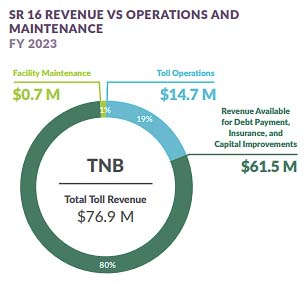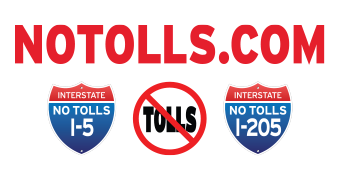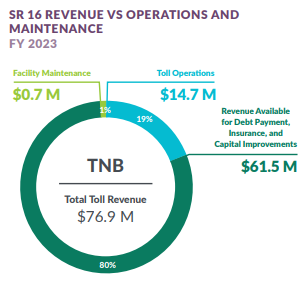Tolls could be three times the amount originally borrowed
Thursday, May 2, 2024 — Clark County Today
John Ley
for Clark County Today
Paying off a transportation credit card with tolling is expensive. Washington state’s experience with the Tacoma Narrows Bridge (TNB) is on track to spend nearly three times the amount originally borrowed. Tolling revenues have fluctuated significantly and political pressures triggered legislature intervention multiple times.
The Narrows Bridge (TNB) is in reality two separate bridges, like the Interstate Bridge. The second bridge was constructed in 2007, doubling vehicle capacity to address growing traffic demand. It is 5,979 feet long, provides 187.5 feet of clearance below for marine traffic and has eight total lanes. Tolls are only collected in the southbound direction.
The bridge was built for $786 million of which $684.2 million was borrowed from Wall Street. The loans were supposed to be paid back by tolling revenues. Yet over the past decade, the Washington State Legislature has provided over a hundred million in subsidies and loans to keep the tolling program for the TNB afloat Most recently was $130 million in 2022, which in part lowered toll rates by 75 cents in October 2022.
After 16 years of paying tolls, the Washington State Transportation Commission (WSTC) reports about $586 million remains to be paid off. This is just $98 million less than the original loan.
The commission projects the bonds will be fully paid off in fiscal year 2030, according to a recent news report. Once the bonds are paid back, toll revenues will go toward deferred sales tax. “Over time they have deferred all the sales tax for the construction of the bridge to after debt services are completely paid off,” WSTC staff member Carl See said..
According to information provided by the WSTC, which oversees the five state tolling programs, $1.03 billion in “adjusted gross toll revenue” has been received since 2007. A total of $891.9 million has been paid on debt of the $1.1 billion in expenditures. Only $479 million went to reduce the principal balance of the loan, with about $413 million paid in interest.
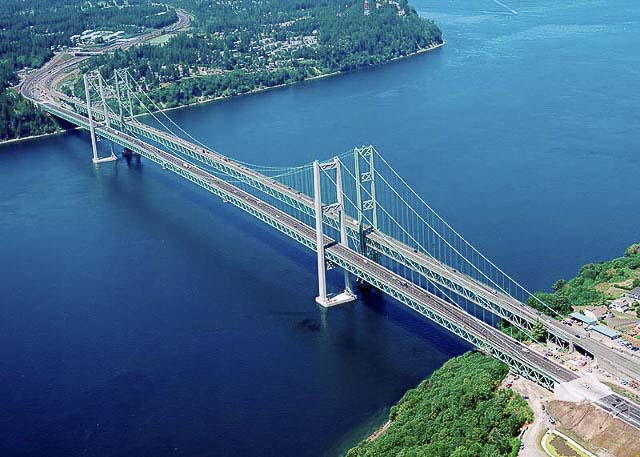
This is of significant interest to Clark County and Portland metro citizens because the Interstate Bridge Replacement (IBR) program is demanding tolling to pay for a significant portion of the project. The IBR finance plan predicts the need for $1.2 billion to $1.5 billion in borrowed funds, paid for by tolling, in order to cover $6 billion in project expenditures. Yet last December, IBR Program Administrator Greg Johnson told legislators the cost would be increasing, with actual numbers to be revealed this summer.
Where will the increased money come from? One likely source will be increased borrowing, paid for by tolls. The largest impact of tolling will be on Clark County and Southwest Washington residents who commute to work in Oregon. Over 75,000 Clark County residents commute to earn a paycheck in Oregon.
How well has Washington state done in managing the TNB tolling program over the past 17 years? A subcommittee of Transportation Commission members from Oregon and Washington are currently discussing numerous aspects of tolling the IBR. Clark County’s Roy Jennings is one of those members.
Jim Restucci also represents the WSTC. Lee Beyer and Alicia Chapman represent the Oregon Transportation Commission. Their first meeting was in March, reported here. Initial IBR toll charges discussed range from $1.50 to $3.55 per crossing, with higher prices when the bridge has more traffic. The evaluation expects an inflation rate applied to toll rates of 2.15 percent a year.
What is the history of the TNB tolling program? How often has the legislature used other funds to bail out the program? Will this portend problems for borrowing to help fund the IBR? Current toll rates on the TNB are $4.50 with a “Good to Go” pass and $6.50 if paid by mail. This is 75 cents lower than two years ago.
In 2022, Washington Gov. Jay Inslee signed SSB 5488. It approved transferring $3.25 million per year in General Fund tax revenues to the TNB tolling account for the rest of the decade. The total amount that may be transferred is $130 million. This is just the most recent injection of cash into the TNB program.
The legislative summary provided the following history.
- 2007 — loan of $5.3 million, scheduled to be fully repaid by the 2023-25 biennium;
- 2012 — deferral of the $57.6 million repayment of the sales tax for construction of the bridge until fiscal year 2032 after the debt service is fully paid;
- 2018 — declaration of legislative intent in SHB 2990, to provide a series of loans up to $85 million to keep TNB toll rates at no more than $0.25 higher than 2018 Rates — $43 million of this amount has been, or is appropriated to be, transferred to the TNB account by 2023; and
- 2019 — loan of $5 million to maintain minimum fund balance, paid back in 2020.
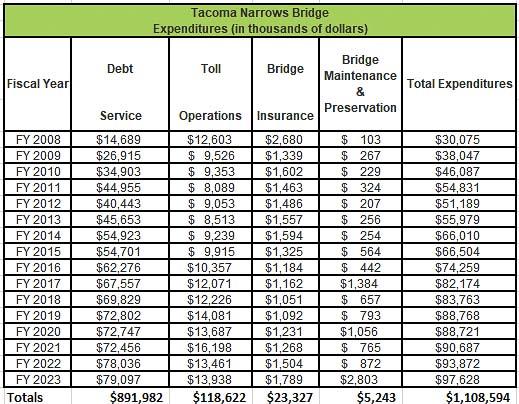
Aaron Halbert of the WSTC staff told Clark County Today “by June 30, 2024, the remaining outstanding principal will be approximately $168.2 million. The original bonds were issued in 2002 by the state with planned payoff by 2030. The total borrowed via bonds was $684 million and the cost of issuing the bonds was $6.4 million.”
In 2021, the Washington legislature appropriated a $30.3 million loan to the TNB account for the 2021-23 biennium, and a subsidy of $15.7 million in federal ARPA funds, according to the WSTC report. They also report “unfunded loan needs total $44.1 million for FY 2024 – FY 2030.”
If your head is spinning with all these numbers, don’t feel bad. The multiple loans and subsidies serve to remind voters that nothing in the execution of the TNB tolling system has gone as originally planned. The program will run at least three years beyond the initial schedule, with state legislators bowing to a variety of political pressures to subsidize tolls and reduce the angst of voters.
It would appear the final price tag for borrowing the $684 million could approach $2 billion by the end of 2033. That would be nearly triple the amount borrowed.
As of the end of Fiscal Year 2023, $118 million has been spent on toll operations; $23 million on insurance; and just $5 million on bridge maintenance and preservation.
System wide, the cost of collection on the five state tolling facilities is 21 percent. On the TNB, collection costs amount to 19 percent according to their most recent annual report. Less than one percent went to maintenance. On the SR 520 bridge over Lake Washington, collection costs are 30 percent. The SR 167/I-405 toll lanes have a 35 percent cost of collection.
Tolling revenues have fluctuated significantly over the past decade. Two years ago, state tolling revenues were down $158 million due to the pandemic with a $464 million drop over a decade.
Oregon Gov. Tina Kotek recently stopped planned “per mile” tolls, due to citizen outrage in Oregon. Yet some in the Oregon legislature hope to resurrect them in the 2025 session.
Perhaps the lessons from the Tacoma Narrows Bridge will cause elected officials to avoid such an expensive and controversial means of raising transportation funds. But will they walk back tolling on the Interstate Bridge? Will the federal government refuse to approve tolling on this expensive project? Time will tell.
